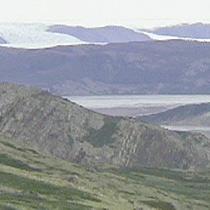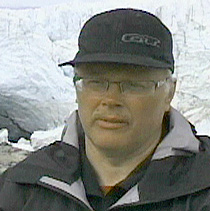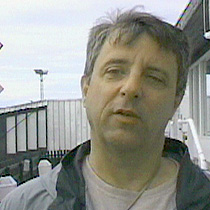2007年VOA标准英语-Greenland Hopes Tourism Will Raise Global Warmi(在线收听)
Kangerlussuak, Greenland
12 July 2007
The former Danish colony of Greenland attained home rule in 1979. Since it began governing itself, with support from the Danish government, in 1981, Greenland has made an effort to modernize its fishing-dominated economy. Better telecommunications and more flights from Europe and the United States are making tourism the fastest growing part of the economy. VOA's Kane Farabaugh spent a week above the Arctic Circle to explore why people are heading north to explore Greenland's natural beauty.
 |
| The picturesque landscape of Greenland |
Twisting through this picturesque landscape is a lonely road that leads to the edge of the habitable earth.
It is a road familiar to Kim Petersen. He has traveled these parts often in his career as an adventure tour guide. He works for one of two tourism companies operating in Kangerlussuak, at the end of the Sondestrom Fjord.
 |
| Kim Petersen, tour guide |
Work is picking up for Petersen. It is the summer season, when mosquitoes swarm and the sun never sets -- the perfect time for visitors to watch up close as the ice breaks off the massive, slow moving glacier.
"I can see the difference,” Petersen adds. “I have been here for 22 years now, and I can see the ice is getting thinner in this area here."
The issue of global climate change is helping the tourism industry in Greenland, with Kangerlussuak at the center of the boom. If you have e never heard of Kangerlussuak, you are not alone. It is what is left of Sondrestrom U.S. Air Force Base, a Cold War outpost originally built as a way station for military planes on the way to Europe.
The people of Greenland took it over in 1992, and are turning this sleepy town on the edge of a waterway into an eco-tourism destination.
 |
| Michael Pastirik, a teacher from Atlanta, Georgia |
"It feels different. It feels like you are on the edge," says Pastirik. "I think there's stuff to do here. It doesn't have all the majesty of all the tourism spots you hear about all over the world, but it is a beautiful? Starkness. There's certain starkness. You know, you can take bike rides here. There are trips to the glacier. The black old rock that you see around us is spectacular.
The first non-stop commercial flights from the United States to Greenland began in May. Several European carriers also have routes to Kangerlussuak. According to Greenland's official website, in 1999, more than 26,000 passengers arrived by air. That number jumped to some 33,000 in 2005, a number that continues to rise with added routes.
Cruise ships also dock outside Kangerlussuak. While many ship passengers might not stay the night at one of the three hotels in town, they visit the area and spend money. Tours, like the ones that Kim Petersen operates, are a popular draw for cruise passengers.
All of this translates into money pouring into the local economy.
While tourism is on the rise, Greenland might not be for everyone. It is the world's largest island and 85 percent of it is covered in ice. "People who like to live on the edge, I think would find enjoyment here," says Pastirik.